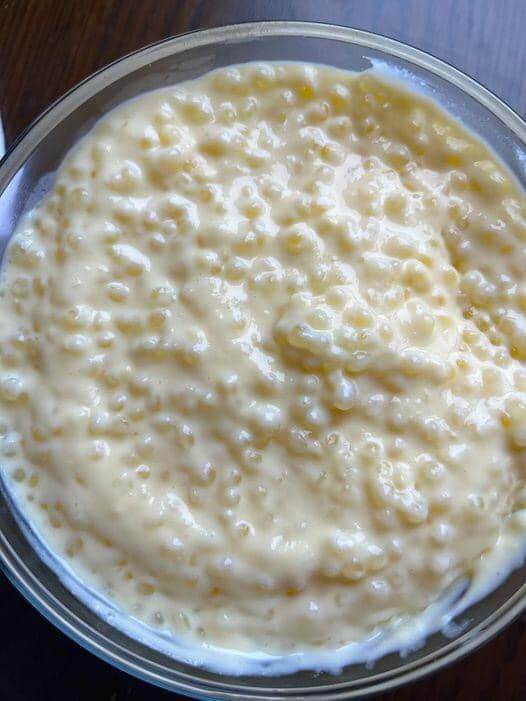Homemade Tapioca Pudding Recipe
There is a special kind of comfort found in classic homemade desserts, and tapioca pudding is one of those timeless treats that never seems to lose its charm. It is creamy, lightly sweet, and pleasantly textured, offering a nostalgic reminder of simpler times. Long before instant puddings became common, families would slowly simmer small pearls of tapioca with milk and sugar to create a dessert that felt cozy and satisfying. Even today, this homemade version stands above store-bought options in flavor, richness, and texture. Making it from scratch is surprisingly easy, and once you try it, you may find yourself returning to this recipe again and again.
Tapioca pudding begins with simple ingredients: milk, sugar, small tapioca pearls, and eggs. Each ingredient contributes to its characteristic creaminess, and the gentle cooking process allows the pearls to soften slowly. The secret to great tapioca pudding is patience. Rushing the process can result in unevenly cooked pearls or milk that scorches at the bottom of the pan. Taking your time ensures a smooth and silky pudding with pearls that are plump and tender.
To make a classic homemade tapioca pudding, start by soaking half a cup of small pearl tapioca in water for about 30 minutes. This step softens the pearls and shortens the cooking time. After soaking, drain any excess water and set the pearls aside. In a medium saucepan, combine three cups of whole milk and the soaked tapioca. Heat the mixture over medium-low heat, stirring constantly to prevent sticking. As the mixture warms, the pearls begin to turn translucent, signaling that they are absorbing the milk and thickening the base.
Once the milk mixture begins to gently simmer, stir in one-third cup of sugar. Let the mixture continue to cook, stirring often, until the pearls are completely translucent and the pudding begins to thicken. This usually takes around 15 minutes. Keeping the heat low is important here because high heat can cause the milk to curdle or scorch. A slow and steady simmer is ideal.
Next comes the step that gives tapioca pudding its creamy richness. In a small bowl, whisk two eggs. To avoid scrambling the eggs when they meet the hot mixture, temper them by adding a small amount of the hot tapioca into the bowl while whisking constantly. This raises the temperature gradually. Once the eggs are warmed, pour the mixture back into the saucepan and continue cooking on low heat for a few more minutes. The pudding should thicken further and take on a smooth texture.
A splash of vanilla extract at the end enhances the flavor beautifully. Vanilla pairs perfectly with the creamy milk and gentle sweetness, giving the pudding a warm and comforting aroma. Once the pudding reaches your desired thickness, remove it from the heat and let it cool slightly. It will continue to thicken as it cools. Some people enjoy their tapioca pudding warm, right off the stove, while others prefer it chilled. Either way, it is delightful.
One of the reasons tapioca pudding has remained popular across generations is its versatility. Some prefer it extra creamy, while others enjoy a firmer consistency. Adjusting the milk or tapioca ratio allows you to tailor it to your preference. You can also customize the sweetness, or add spices such as cinnamon or nutmeg for a warm twist. A spoonful of coconut milk adds richness and tropical flavor, while a bit of lemon zest brightens the pudding with a subtle citrus note.
Another charming feature of tapioca pudding is how well it pairs with fruit. Fresh berries, sliced bananas, or warm cinnamon apples all complement its silky texture. A spoonful of jam swirled into the warm pudding creates a marbled effect that looks beautiful and tastes even better. Some families even serve tapioca pudding with a small dollop of whipped cream on top, especially during holidays or special gatherings.
This recipe is also adaptable for people with dietary preferences. Tapioca is naturally gluten-free, making this dessert an ideal choice for those avoiding wheat. It can be prepared with plant-based milks such as almond, coconut, or oat milk. Just keep in mind that plant-based versions may cook slightly faster or slower, depending on their thickness. Sweeteners like honey, maple syrup, or agave can replace sugar, though liquid sweeteners may slightly alter the texture. Because tapioca pudding is forgiving, these variations usually turn out wonderfully.
One of the best things about tapioca pudding is how well it stores. After cooling to room temperature, it can be poured into jars or containers and refrigerated for up to four days. It thickens even more as it chills, so adding a splash of milk when reheating helps return it to its original creaminess. Children often love it as a lunchbox treat, and adults enjoy it as a simple dessert after dinner. Its homemade charm makes it feel both comforting and a little special.
While many modern desserts rely on heavy layers, frostings, or complex methods, tapioca pudding celebrates simplicity. Its beauty lies in its humble ingredients, gentle cooking process, and classic flavor that reminds many people of childhood or family gatherings. Whether served warm on a cozy evening or chilled on a warm day, it offers a soothing experience that feels familiar and inviting.
Homemade tapioca pudding is more than just a dessert; it is a memory, a tradition, and a reminder that comforting food does not have to be complicated. With just a handful of ingredients and a bit of patience, you can enjoy a creamy treat that has stood the test of time. If you are looking for a classic dessert that brings people together and satisfies with every spoonful, this recipe will never disappoint.
